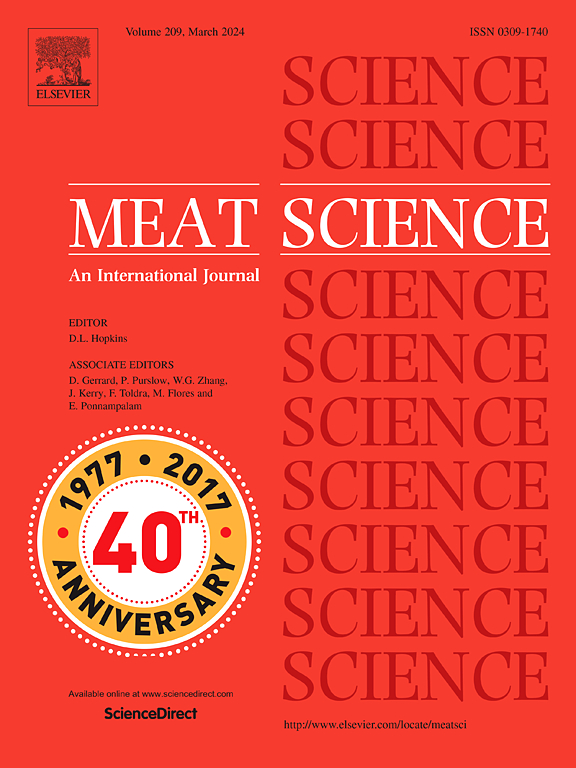Evaluation of salami packed under different packaging materials
IF 6.1
1区 农林科学
Q1 Agricultural and Biological Sciences
引用次数: 0
Abstract
The global demand for meat products has risen significantly over the past decades, leading to concerns over spoilage and safety due to the perishable nature of meat. This study evaluates the effectiveness of alternative, more sustainable plastic packaging materials on the quality evolution of whole and pre-sliced salami packed in modified atmosphere. In particular, whole salami was packaged using BOPA/EVOH-PE as the control material, and BOPP-ALOx/PP as the alternative solution. For pre-sliced salami, the conventional packaging consisted of Bio-PET/R-PET/PET tray with upper BOPET film, while the more sustainable alternative was represented by Bio-PET/R-PET/Bio-PET tray with upper PET-ALOx film. The impact of packaging on color stability, microbial growth, lipid oxidation, and chemical attributes was examined during a 90-day storage period at 4 °C. Results indicated that the alternative single-material packaging used for whole salamis, characterized by higher water vapor and oxygen barrier properties, led to condensation issues during storage. The combination of limited moisture and gas exchange contributed to a higher final water activity (aw) and inhibited surface mold development, resulting in an external color shift toward darker shades. Conversely, for pre-sliced salamis, minimal differences in qualitative attributes were observed between the products stored in the two different packaging systems. The significantly lower CO2 levels and slight decrease in aw in the salamis packaged in Bio-PET/R-PET/Bio-PET trays were attributed to its higher gas and water vapor permeability compared to the conventional system. These findings underscore the potential of alternative and more sustainable packaging materials to enhance meat product preservation.
不同包装材料下腊肠包装的评价
在过去的几十年里,全球对肉类产品的需求大幅上升,由于肉类易腐烂的性质,导致人们对腐败和安全的担忧。本研究评估了可替代的、更可持续的塑料包装材料对整条和预切片意大利腊肠在改性气氛中包装的质量演变的有效性。以BOPA/EVOH-PE为对照材料,BOPP-ALOx/PP为替代溶液,对整条腊肠进行包装。对于预切片腊肠,传统的包装是Bio-PET/R-PET/PET托盘,上面有BOPET薄膜,而更可持续的替代品是Bio-PET/R-PET/Bio-PET托盘,上面有PET- alox薄膜。在4°C条件下90天的贮藏期中,研究了包装对颜色稳定性、微生物生长、脂质氧化和化学特性的影响。结果表明,采用单一材料包装的整条香肠具有较高的阻水性和阻氧性,导致其在储存过程中出现冷凝问题。有限的水分和气体交换的结合导致了更高的最终水活度(aw),并抑制了表面霉菌的发育,导致外部颜色向更深的色调转移。相反,对于预切片的腊肠,在两种不同包装系统中存储的产品之间观察到定性属性的最小差异。在Bio-PET/R-PET/Bio-PET托盘中包装的腊肠中,二氧化碳含量显著降低,aw含量略有下降,这是由于与传统系统相比,它具有更高的气体和水蒸气渗透性。这些发现强调了替代和更可持续的包装材料的潜力,以加强肉类产品的保存。
本文章由计算机程序翻译,如有差异,请以英文原文为准。
求助全文
约1分钟内获得全文
求助全文
来源期刊

Meat Science
工程技术-食品科技
CiteScore
12.60
自引率
9.90%
发文量
282
审稿时长
60 days
期刊介绍:
The aim of Meat Science is to serve as a suitable platform for the dissemination of interdisciplinary and international knowledge on all factors influencing the properties of meat. While the journal primarily focuses on the flesh of mammals, contributions related to poultry will be considered if they enhance the overall understanding of the relationship between muscle nature and meat quality post mortem. Additionally, papers on large birds (e.g., emus, ostriches) as well as wild-captured mammals and crocodiles will be welcomed.
 求助内容:
求助内容: 应助结果提醒方式:
应助结果提醒方式:


